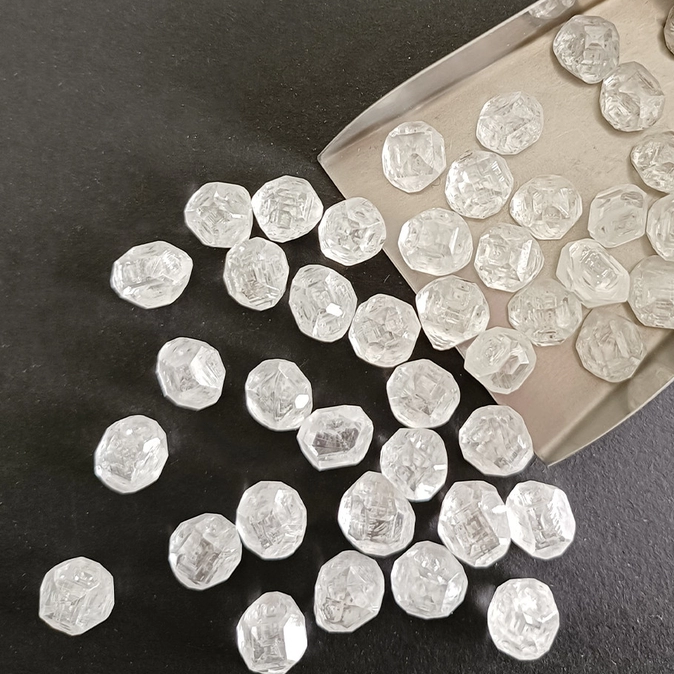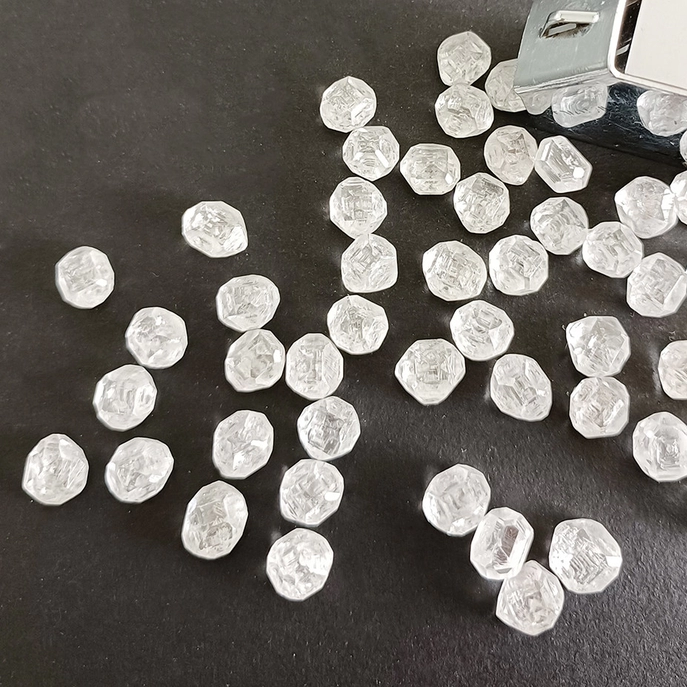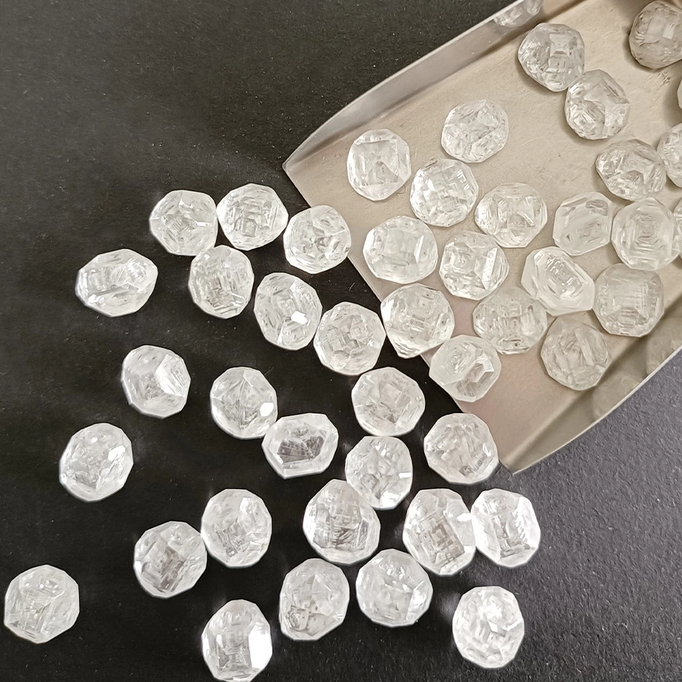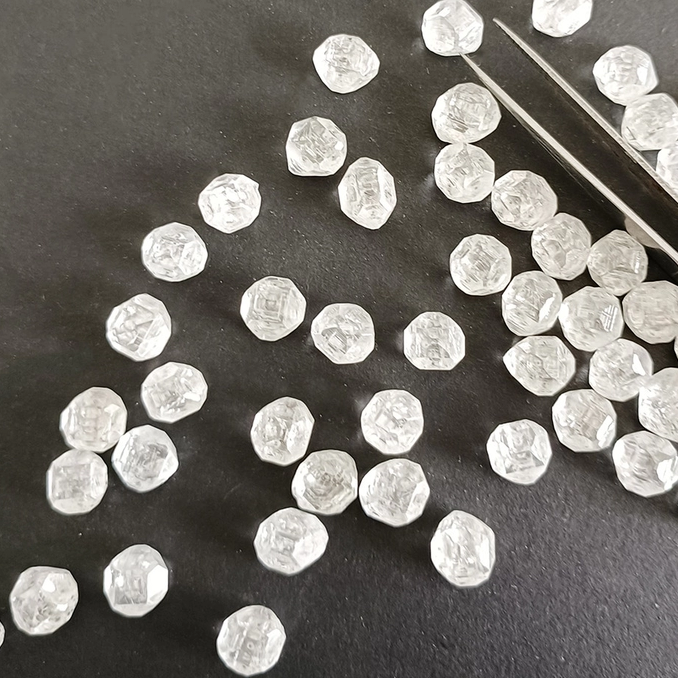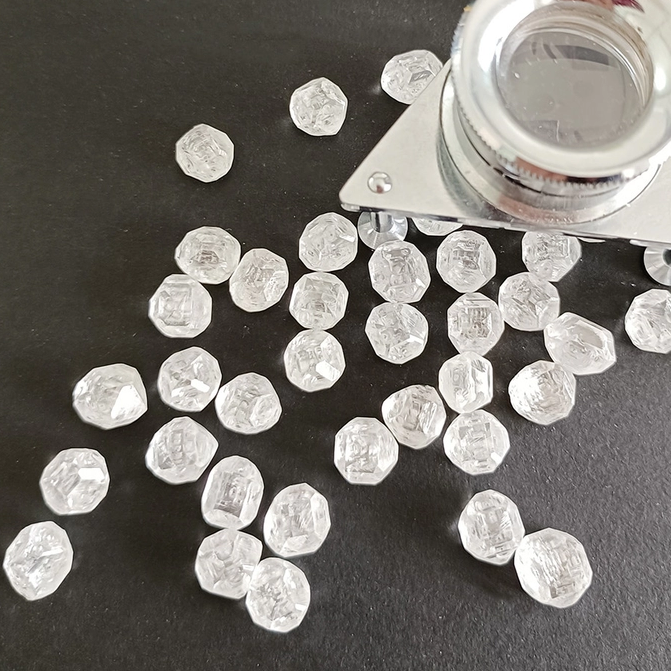VVS VS Clarity Rough HPHT Lab Grown Diamonds Big Size DEF Color
Lab Grown Diamonds Description
The development of artificial cultivation technology has provided more possibilities for life. Lab grown diamonds has overturned the traditional positioning of jewelry, allowing consumers to buy larger and better-cut diamonds for the same budget. The flexibility to tailor size, shape, color and other visual features to your own needs has made Grow Diamonds a hit with a new generation of consumers. At the end of the 18th century, Lavoisier, a French chemist, discovered that diamond is a single crystal composed of carbon elements formed under high pressure and high temperature conditions in the deep earth, which laid the theoretical foundation for the subsequent cultivation of diamond technology.
In 1952, the United States federal silicon carbide company scientists – William eversau use Chemical Vapor Deposition method (Chemical Vapor Deposition, referred to as CVD), let contain carbon gas continuously deposited on the diamond seed crystal, gradually accumulated hardening to form diamonds.
In 1954, ge super pressure project led by Dr Hall, head of the team, in cultivating diamond technology breakthrough, invented the “method of high temperature and high pressure synthesis of diamond” (High Pressure High Temperature, HPHT).
Rough HPHT Lab Grown Diamonds


If you’re interested in buying a diamond, you may want to know what rough HPHT lab-grown diamonds are and how they are made. These gems are produced using cubic presses and are known for being strong, durable, and environmentally friendly. Read on for more information! : Why Are Rough HPHT Lab Grown Diamonds Important? – What Are the Benefits of This Gemstone?
Cubic presses produce rough HPHT lab-grown diamonds
HPHT or High-Pressure High-Temperature is a process used to grow diamonds in a laboratory. Most diamonds produced using this method are colourless or brown. However, it is possible to create diamonds with green, blue, or even red hues using a combination of HPHT, irradiation, and annealing. The price of HPHT lab-grown diamonds varies depending on the type of setting.
Inclusions are the hallmark of a diamond and they are unique to natural and lab-grown varieties. They are reflections of the growing environment in which diamonds form. While inclusions in natural diamonds are nearly identical to those of lab-grown diamonds, inclusions in HPHT and CVD-grown varieties are different. Cubic presses, for example, use a synthesis capsule – a cylindrical ceramic capsule measuring two centimetres in cube size – to produce lab-grown diamonds.
HPHT lab-grown diamonds were first considered gem-quality in 1971, averaging six millimeters in diameter. This method involved a temperature gradient in the diamond cell, concentrating carbon in one location. In contrast, CVD diamond synthesis took longer – the first stone was produced in 1952 – but it was not until the 2000s that facetted gem-quality diamonds hit the market.
In the HPHT lab-grown diamond production process, a small diamond seed is inserted into the growing medium. The high temperature then causes the diamond to grow around the seed. Once the growth cell is complete, the newly formed diamond can be polished and cut. This process yields a rough diamond ready for polishing and cutting. It also increases the durability of the diamond. There are two major types of HPHT lab-grown diamonds: rough and polished.
They are environmentally friendly
The environmental impact of mining diamonds is enormous. In fact, the energy needed to grow a lab-grown diamond is half the amount used to mine a diamond. While some companies are transitioning to renewable energy or capturing CO2, more companies need to take the next step in reducing their climate impact. However, some traditional diamond mining companies are trying to address industry impacts with social programs, such as building schools and medical facilities. Those efforts are great, but if we can’t keep a finger of their thumb on the scale of a planet, that’s even better.
The benefits of lab-grown diamonds are many. These gemstones can be cut into classic shapes and used to create jewelry pieces. These diamonds are also available in a variety of colors and styles. If you’re looking for the perfect engagement ring, lab-grown diamonds are a great alternative to natural diamonds. Additionally, you can choose from a variety of styles, sizes, and lengths.
When choosing a diamond, you need to consider how much you’re willing to spend. A natural diamond is a one-of-a-kind, valuable stone. However, lab-grown diamonds can be found for a fraction of the cost. If you’re committed to sustainability, you may choose a lab-grown stone instead, but the environmental impact of mined diamonds is less. As long as the diamond is grown using renewable energy, there’s no need for concern.
CVD is a new trend in diamond manufacturing that uses carbon in a 3D printing process. This method involves heating hydrogen and methane gas to extremely high temperatures. As these gasses condense into plasma, the carbons attached to the diamond seed begin to grow. The finished diamond is then polished by high-tech lasers. The resulting diamond is chemically identical to a natural diamond.
They are versatile
Although they are similar to natural diamonds, Rough HPHT Lab Grown Diamonds can be shaped into a variety of shapes. The most noticeable difference between natural diamonds and HPHT lab grown diamonds is the cost. Natural diamonds are far more expensive due to the many hands they pass through during the production process. The most significant cost savings, however, will come from purchasing a Rough HPHT Lab Grown Diamond.
As natural diamonds are extremely expensive, they are out of reach for many people. These people are looking for alternatives that will not break the bank. While Rough HPHT Lab Grown Diamonds are not as precious or durable as naturally mined diamonds, their cost is much less expensive. In fact, many people find lab grown diamonds to be a good alternative. Despite their lower price, they still offer high-quality stone.
Rough HPHT Lab Grown Diamonds have a wide range of uses. Unlike the traditional “natural” diamond, HPHT lab grown diamonds can be cut, shaped, and polished. While they are often white in color, HPHT diamonds can be tinted or faceted to suit the wearer’s taste. The process used to create Rough HPHT diamonds is completely fixed. This means they do not need regular maintenance, like a natural diamond does.
These stones are the same chemical composition as natural diamonds, so it is difficult to tell them apart. They are colorless or near-colorless, and can be faceted and cut just like diamonds of 10 carats and higher. Rough HPHT Lab Grown Diamonds also have the potential to be faceted to match a wide range of settings. The inclusion of boron in the growth process produces blue crystals, but post-growth treatments involving heat or radiation can produce the desired colors.
They are strong
If you’re looking for a strong, beautiful diamond, consider HPHT-grown gems. These gems are identical to natural diamonds, but are much cheaper. Mining for natural diamonds is a costly process, and diamonds pass through several hands before being sold. In contrast, lab-grown diamonds don’t have to go through as many hands. They are also environmentally friendly, since no deposits have to be mined to create them.
Another technique involves chemical vapor deposition (CVD). Using a small diamond seed, CVD creates a diamond in a chamber that is heated to over 1,400 degrees Fahrenheit. Carbon-rich gas is then ionized, breaking molecular bonds and adhering to the diamond seed, slowly building up into a crystal. After this, it’s ready for sale.
A major advantage of lab grown diamonds is their consistency. Because of the controlled manufacturing process, the diamonds are as strong as natural diamonds but are more affordable. Since the process does not involve nitrogen, these diamonds are less likely to be harmed during their lifetime. The added benefit is that they’re not prone to losing their original luster or color. They’re also more durable than diamonds that are carved from a single rock.
Unlike natural diamonds, Rough HPHT Lab Grown Diamonds don’t contain metallic inclusions. In addition, these gems often contain dark graphite that does not exhibit metallic luster. The banded “strain” patterns in natural diamonds help differentiate them from HPHT synthetic diamonds. This is a characteristic that distinguishes Rough HPHT lab grown diamonds from CVD diamonds.
They have metallic inclusions
Metallic inclusions are not uncommon in HPHT laboratory grown diamonds. They are a result of the HPHT process, in which the carbon in the diamond seed is replaced with a metallic catalyst. The metal combines with carbon in the diamond crystal, trapping pieces of the catalyst within the stone. The most common form of metallic inclusion is a dark rod-like feature. Under magnification, these inclusions are reflective and appear man-made.
The structure of a diamond is responsible for its properties. A diamond’s tetrahedral bonds are extremely strong, and form only under extreme conditions. In nature, diamond forms deep within the earth’s crust under tremendous pressure. Because of this, the process to create a diamond in the lab is very difficult. However, scientists are able to create diamond crystals by combining two processes. One of these processes is called High Press High Temperature, and the other is known as carbon vapor deposition.
While diamonds can be easily recognized by visual features, rough HPHT lab grown stones can also have metallic inclusions. Metal inclusions can affect the value of a diamond. These inclusions often cause the brilliance of the stone to be less than desirable. If you buy a rough diamond, it may be difficult to determine whether it is real or fake. Rough HPHT lab grown diamonds with metallic inclusions are usually cheaper than synthetic diamonds. They are also more likely to contain metallic flux, which affects their value.
The most obvious feature of a lab-grown diamond is its color. When exposed to ultraviolet light, diamonds glow a different color. This color change is called phosphorescence and is a common way to distinguish a natural diamond from a lab stone. Although this effect may be less common in diamonds treated with CVD, it is still a characteristic that differentiates natural from lab-grown diamonds. It’s possible to recognize HPHT lab-grown diamonds by its inclusions, which help identify them as a fake.
VVS VS Clarity Rough HPHT Lab Grown Diamonds Big Size DEF Color
